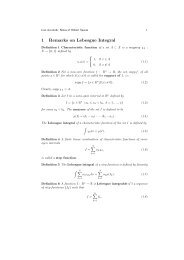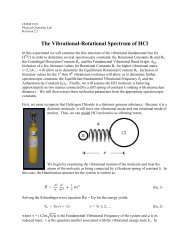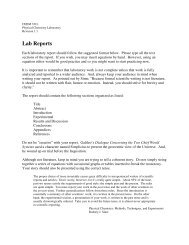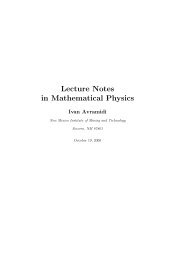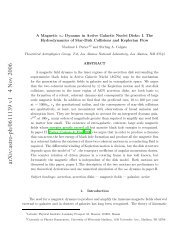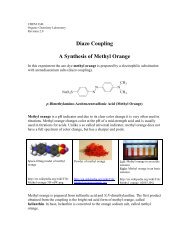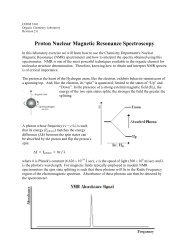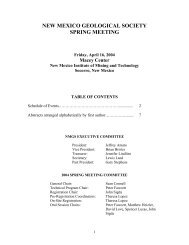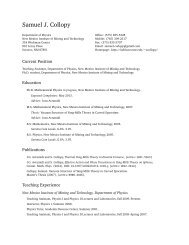Calorimetry and Thermochemistry
Calorimetry and Thermochemistry
Calorimetry and Thermochemistry
Create successful ePaper yourself
Turn your PDF publications into a flip-book with our unique Google optimized e-Paper software.
CHEM 121L<br />
General Chemistry Laboratory<br />
Revision 1.1<br />
<strong>Calorimetry</strong> <strong>and</strong> <strong>Thermochemistry</strong><br />
• Learn how to measure Heat flow.<br />
• Learn about the Specific Heat of substances.<br />
• Learn about Exothermic <strong>and</strong> Endothermic chemical reactions.<br />
• Learn about the Enthalpy function.<br />
In this laboratory exercise we will measure the Specific Heat of a metal <strong>and</strong> determine the<br />
Enthalpy of Reaction (∆H) for two solvation processes; the solvation of Magnesium Sulfate<br />
Heptahydrate <strong>and</strong> the solvation of its Anhydrous salt. These measured Enthalpy changes will<br />
allow us to determine the amount of heat required to dehydrate the hydrated salt. Each of these<br />
three experiments will require us to measure the amount of Heat (q) produced or absorbed during<br />
the process or chemical reaction. This measurement will be performed within a Calorimeter.<br />
Heat Flow (q) is generally thought of as the transfer of thermal energy from a "hot" object to a<br />
"cold" object. The warming of a soft drink on a hot day is a typical example of this transfer. The<br />
“hot” Air loses thermal energy <strong>and</strong> the “cold” soft drink gains it. However, nearly all chemical<br />
reactions involve the release or absorption of heat as well. The burning of Coal is a dramatic<br />
example of a chemical reaction in which a great deal of heat is released.<br />
C(s) + O 2 (g)<br />
CO 2 (g) + Heat<br />
Thermal energy stored in the bonds of the reactants is transferred to the cold surroundings as the<br />
reaction proceeds. Dissolving the salt Potassium Nitrate in water is an example of a chemical<br />
reaction in which heat is absorbed. As the salt dissolves, the solution becomes quite cold.<br />
KNO 3 (s) + Heat<br />
K + (aq) + NO 3<br />
- (aq)<br />
This type of reaction is the basis for chemical cold packs used to treat minor injuries. In many<br />
instances, this transfer of Energy, measured in units of calories or Joules, can be quantified by<br />
observing the changes in temperature of the respective objects as heat flows between them.<br />
The change in temperature (∆t) of a given substance as heat flows into or out of the substance<br />
will depend on the magnitude of the heat flow (q), the mass of the substance (m), <strong>and</strong> the "ability<br />
of the substance to absorb or release heat". The ability of a substance to absorb or release heat is<br />
simply the Specific Heat (sp) of the substance. Substances with large specific heats are "heat<br />
sponges" <strong>and</strong> can absorb a considerable amount of heat without a significant change in<br />
temperature. Water has a fairly high specific heat. Substances with small specific heats are<br />
"heat conductors." Metals are good conductors of heat <strong>and</strong> so have small specific heats. In<br />
terms of the temperature change, the heat flow is given as:
P a g e | 2<br />
q = sp x m x ∆t (Eq. 1)<br />
Substance sp (cal/g o C)<br />
Graphite 0.170<br />
Gold 0.0308<br />
Water 1.00<br />
Ethanol 0.588<br />
Wood 0.421<br />
Cement 0.210<br />
Glass 0.201<br />
The measurement of heat flows during physical <strong>and</strong> chemical processes is called <strong>Calorimetry</strong>.<br />
<strong>Calorimetry</strong> involves observing the temperature change of a calorimetric substance, usually<br />
Water, as it absorbs or releases the heat by-product of said reaction or process. The system<br />
which contains the calorimetric substance <strong>and</strong> the reaction/process is called a Calorimeter. A<br />
simple Coffee-Cup Calorimeter is pictured below. The Styrofoam walls of the coffee cup make<br />
an excellent insulator for the calorimeter; ie. there is extremely little heat flow to <strong>and</strong> from the<br />
surroundings. The calorimetric substance is Water, whose specific heat is 1.00 cal/goC. The<br />
temperature of the Water can easily be observed. If the mass of the Water in the calorimeter is<br />
known, then the heat flow can be calculated via the equation given above. A simplifying<br />
assumption, which is fairly easily relieved, is that the calorimeter itself absorbs or releases<br />
relatively little heat during the course of the measurements. For the small heat exchanges<br />
involved in the cases examined in this experiment, this simplifying assumption is fairly good.
P a g e | 3<br />
We will consider two different calorimetric measurements; heat flow out-of a hot metal <strong>and</strong> heat<br />
flow during two different chemical reactions. The first, measuring the heat flow out-of a metal,<br />
will allow us to determine the specific heat (sp) of the metal. The second set of measurements,<br />
heat flow during chemical reactions, will allow us to predict the heat requirements of a chemical<br />
reaction for which it is difficult to measure the heat flow.<br />
Specific Heat of a Metal<br />
To measure the specific heat of a metal, the metal is heated to a known temperature. The "hot"<br />
metal is then placed in the Water in the calorimeter. The temperature change of the Water in the<br />
calorimeter is observed. (See picture below.)<br />
The heat flow into the Water can be calculated.<br />
q wat = (1.00cal/goC) x (m wat ) x (∆t wat )<br />
By the Law of Conservation of Energy, the heat flow out of the metal must equal the flow into<br />
the Water:<br />
q met = q wat (Eq. 2)
P a g e | 4<br />
(Again, this assumes the Calorimeter absorbs very little heat; a good assumption for our<br />
experiment.) Finally, the specific heat of the metal can be determined via:<br />
spmet =<br />
q met<br />
(mmet )x(∆t met ) (Eq. 3)<br />
Thermochemical Measurements<br />
<strong>Thermochemistry</strong> is the study of the quantity of heat absorbed or produced by chemical<br />
reactions. A chemical reaction is Exothermic when heat is produced <strong>and</strong> Endothermic when heat<br />
is absorbed. To measure the heat flow during a chemical reaction, the chemical reaction is<br />
carried out inside a calorimeter <strong>and</strong> the temperature change for the calorimetric fluid is observed.<br />
This can be done in a couple of different ways. If the reaction occurs in an aqueous<br />
environment, the reaction can be carried out directly in the Water of the calorimeter. In this case,<br />
the Water is acting as both a solvent <strong>and</strong> the calorimetric substance. (This arrangement is typical<br />
for acid-base neutralization reactions <strong>and</strong> for the solvation of salts.) If not, the reaction can be<br />
carried out inside a metal encased "bomb" which is then immersed into the Water of the<br />
calorimeter. (This arrangement is typical for combustion reactions.) In either case, the heat flow<br />
into the Water can be calculated:
P a g e | 5<br />
qwat = (1.00cal/g oC) x (mwat ) x (∆t wat )<br />
By the Law of Conservation of Energy, the heat flow accompanying the chemical reaction must<br />
be equal to the heat gained or lost by the water:<br />
q rxn = q wat (Eq. 4)<br />
(Again, this assumes no heat is absorbed by the Calorimeter.) This is as pictured below, for a<br />
chemical reaction which is exothermic <strong>and</strong> occurs in an aqueous environment.<br />
For reactions which occur under conditions of constant Pressure, which is the case for the<br />
reaction pictured above, <strong>and</strong> is typical of many chemical reactions, the heat flow is defined as the<br />
Change in the Enthalpy (∆ H) for the reaction:<br />
∆H = q rxn at const. Pressure (Eq. 5)<br />
= H Products - H Reactants (Eq. 6)<br />
The Enthalpy (H) is a type of Chemical Energy, sometimes referred to as the "Heat Content" of<br />
the reactants. Frequently, the Enthalpy is reported on a per mole basis. By convention,<br />
Endothermic reactions have a positive heat flow <strong>and</strong> hence a positive Enthalpy Change; they are<br />
gaining thermal energy. Exothermic reactions have a negative heat flow <strong>and</strong> hence a negative<br />
Enthalpy Change; they are losing thermal energy.
P a g e | 6<br />
Tabulated enthalpy changes can be used to predict the heat content of a reaction which is<br />
difficult to carry-out or for which measuring the heat flow is difficult.<br />
As an example, suppose we measure the Enthalpy Change for the following two reactions, which<br />
are experimentally easy to carry-out:<br />
Sn(s) + Cl 2 (g) SnCl 2 (s) ∆H = - 325.1 kJoule<br />
SnCl 2 (s) + Cl 2 (g) SnCl 4 (l) ∆H = - 186.2 kJoule<br />
This means the Enthalpy Change for the composite reaction, which is more difficult to carry-out<br />
experimentally:<br />
Sn(s) + 2 Cl 2 (g)<br />
SnCl 4 (l)<br />
can be calculated as:<br />
∆H = -325.1 kJoule + -186.2 kJoule = -511.3 kJoule<br />
Pictorially, this is represented in an Enthalpy Diagram as:
P a g e | 7<br />
In this laboratory we will measure the specific heat for a metal <strong>and</strong> the enthalpy change for the<br />
solvation of MgSO 4 <strong>and</strong> MgSO4 •7H 2O. These measurements will be done in a coffee-cup<br />
calorimeter. The metal’s specific heat will be compared with the known specific heat as<br />
tabulated in reference sources in order to give us a sense of the quality of the measurement. The<br />
enthalpy changes for dissolving anhydrous Magnesium Sulfate, MgSO4 , <strong>and</strong> Magnesium Sulfate<br />
Heptahydrate, MgSO 4 •7H 2 O in Water:<br />
MgSO4•7H2O(s) MgSO4 (aq) + 7H 2O(l) (Eq. 7)<br />
MgSO4 (s) MgSO 4 (aq) (Eq. 8)<br />
will be used to determine the enthalpy change for the dehydration of the Hydrate:<br />
MgSO4•7H2O(s) MgSO4 (s) + 7H 2O(g) (Eq. 9)
P a g e | 8<br />
Pre-Lab Questions<br />
1. Suppose 45.2g of Cadmium metal is heated to 85.1 o C <strong>and</strong> then dropped into the coffee-cup<br />
calorimeter. The coffee-cup calorimeter contains 55.6g of water at 25.0 o C. After the metal<br />
is added, the temperature of the water rises to 27.2 o C. What is the specific heat of<br />
Cadmium?<br />
2. Will our method of measuring the Specific Heat of a Metal work for measuring the Specific<br />
Heat of metallic Calcium? Explain.<br />
3. Suppose the heat released during the combustion of Methanol (CH 3 OH) is measured in a<br />
Bomb Calorimeter:<br />
CH 3 OH(l) + O 2 (g)<br />
CO 2 (g) + H 2 O(g)<br />
In this arrangement, the Methanol <strong>and</strong> Oxygen are sealed in a steel bomb <strong>and</strong> ignited. The<br />
resulting heat release (q rxn ) is measured by noting the rise in temperature of the Water in<br />
the calorimeter. Can we say ∆H = q rxn ? Explain.
P a g e | 9<br />
Procedure<br />
Specific Heat of a Metal<br />
1. Obtain a 50g sample of metal. Weigh this accurately. Place it in a large test tube. Heat the<br />
metal in a boiling water bath for 15 minutes. This brings the temperature of the metal to<br />
100oC.<br />
2. While the metal is heating, construct a coffee cup calorimeter. Place 50g of room<br />
temperature water in the calorimeter. Measure the temperature of the water in the<br />
calorimeter.<br />
3. When the metal is done heating, quickly place the metal in the calorimeter. Stirring<br />
constantly, observe the temperature of the water. Record the maximum temperature<br />
observed.<br />
Thermochemical Measurements<br />
1. Weigh out 12.3g of MgSO 4 •7H 2 O.<br />
2. Construct a coffee cup calorimeter. Place 50g of room temperature water in the<br />
calorimeter. Measure the temperature of the water in the calorimeter.<br />
3. Add the 12.3g of magnesium sulfate heptahydrate to the calorimeter water <strong>and</strong> stir with a<br />
magnetic stirrer. Record the maximum temperature observed.<br />
4. Repeat the process for 6.0g of MgSO 4 .
P a g e | 10<br />
Data Analysis<br />
Specific Heat of a Metal<br />
1. Calculate the heat flow into the water of the calorimeter.<br />
2. Determine the heat flow out of the metal.<br />
3. Calculate the specific heat of the metal.<br />
4. Compare the measured specific heat with the accepted value listed in the CRC H<strong>and</strong>book<br />
of Chemistry <strong>and</strong> Physics. Report the percentage error for your measurement.<br />
5. What is the largest source of error in your experiment?<br />
Thermochemical Measurements<br />
1. Calculate the heat flow into/out-of the water of the calorimeter for the MgSO4•7H2O<br />
solvation. How many moles of the salt is used in this reaction? What is ∆H for the<br />
solvation on a per mole basis? (Be sure to use the correct sign.)<br />
2. Calculate the heat flow into/out-of the water of the calorimeter for the MgSO 4 solvation.<br />
How many moles of salt is used in this reaction? What is ∆H for the solvation on a per<br />
mole basis? (Be sure to use the correct sign.)<br />
3. Consider the hypothetical case of removing the magnesium sulfate from solution <strong>and</strong><br />
reforming the anhydrous salt:<br />
MgSO 4 (aq)<br />
MgSO 4 (s)<br />
What is the molar Enthalpy Change ∆H for this reaction?<br />
4. The Enthalpy Change for the vaporization of Water is:<br />
H 2 O(l)<br />
H 2 O(g)<br />
10.5 kcal/mole. What is the Enthalpy Change for the following reaction:<br />
7 H 2 O(l) 7 H 2 O(g)
P a g e | 11<br />
5. Tabulate the above Enthalpy Change values:<br />
Reaction<br />
∆H (kcal)<br />
MgSO 4 •7H 2 O(s)<br />
MgSO4 (aq)<br />
MgSO 4 (aq) + 7 H 2 O(l)<br />
MgSO 4 (s)<br />
7 H 2 O(l) 7 H 2 O(g)<br />
<strong>and</strong> then determine the Enthalpy Change for the following reaction:<br />
MgSO4 •7H 2 O(s)<br />
MgSO 4 (s) + 7H 2 O(g)<br />
6. Sketch an Enthalpy Diagram for this series of reactions.
P a g e | 12<br />
Post-Lab Questions<br />
1. Suppose your thermometer were reading too high by 1.5 o C. How would this affect your<br />
measurement of the specific heat of a metal using our method?<br />
2. 35g of Gold (sp = 0.0308 cal/g o C) at 100 o C is added to 40g of Water at 22 o C in a Coffee-<br />
Cup Calorimeter. What is the final temperature of the system?<br />
3. What is the Specific Heat of Gold in units of J/gK?<br />
4. Is the Specific Heat an intensive or extensive physical property? Why does this matter?




